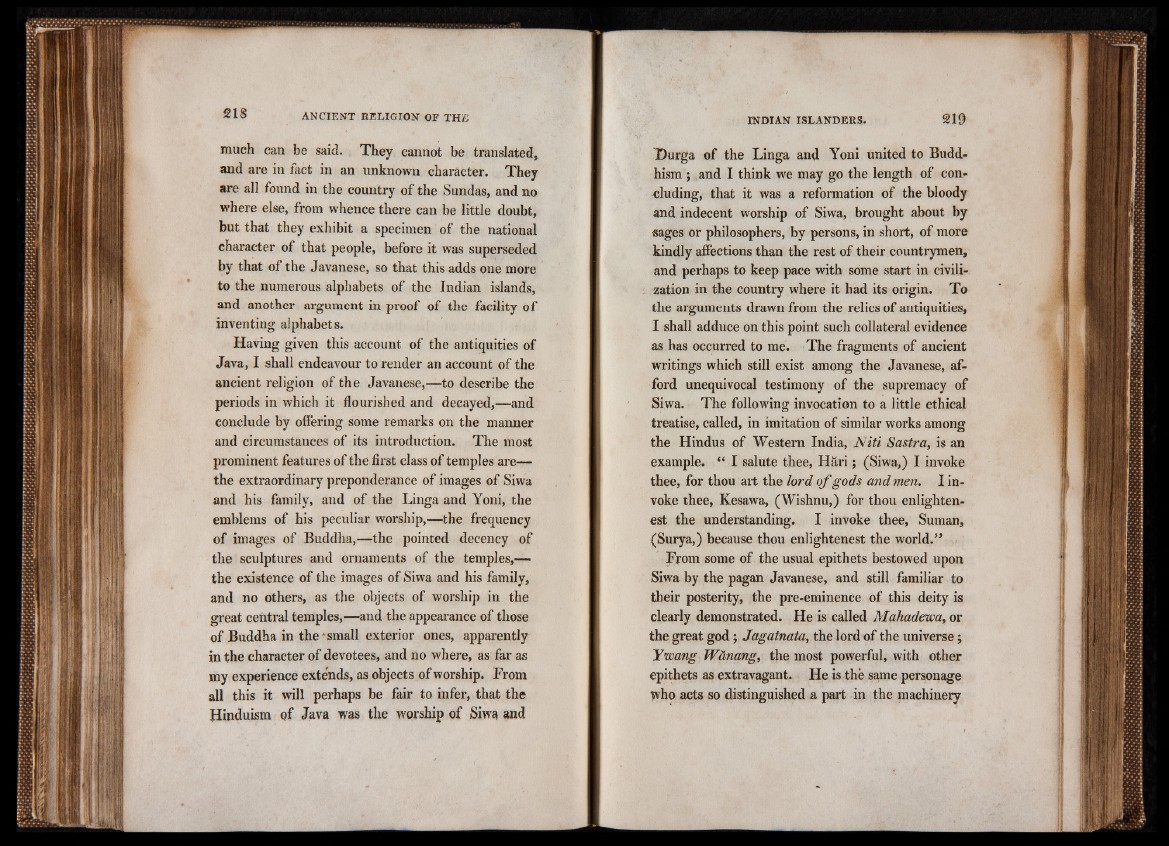
much can be said. They cannot be translated,
and are in fact in an unknown character. They
are all found in the country of the Sundas, and no
where else, from whence there can be little doubt,
but that they exhibit a specimen of the national
character of that people, before it was superseded
by that of the Javanese, so that this adds one more
to the numerous alphabets of the Indian islands,
and another argument in proof of the facility of
inventing alphabets.
Having given this account of the antiquities of
Java, I shall endeavour to render an account of the
ancient religion of the Javanese,—to describe the
periods in which it flourished and decayed,—and
conclude by offering some remarks on the manner
and circumstances of its introduction. The most
prominent features of the first class of temples are—
the extraordinary preponderance of images of Siwa
and his family, and of the Linga and Yoni, the
emblems of his peculiar worship,—the frequency
of images of Buddha,—the pointed decency of
the sculptures and ornaments of the temples,—
the existence of the images of Siwa and his family,
and no others, as the objects of worship in the
great central temples,—and the appearance of those
of Buddha in the small exterior ones, apparently
in the character of devotees, and no where, as far as
my experience extends, as objects of worship. From
all this it will perhaps be fair to infer, that the
Hinduism <?f Java was the worship of Siwa and
Durga of the Linga and Yoni united to Buddhism
j and I think we may go the length of concluding,
that it was a reformation of the bloody
and indecent worship of Siwa, brought about by
•sages or philosophers, by persons, in short, of more
kindly affections than the rest of their countrymen,
and perhaps to keep pace with some start in civilisation
in the country where it had its origin. To
the arguments drawn from the relics of antiquities,
I shall adduce on this point such collateral evidence
as has occurred to me. The fragments of ancient
writings which still exist among the Javanese, afford
unequivocal testimony of the supremacy of
Siwa. The following invocation to a little ethical
treatise, called, in imitation of similar works among
the Hindus of Western India, Niti Sastra, is an
example. “ I salute thee, H ari; (Siwa,) I invoke
thee, for thou art the lord of gods and men. I invoke
thee, Kesawa, (Wishnu,) for thou enlighten-
est the understanding. I invoke thee, Suman,
(Surya,) because thou enlightenest the world.”
From some of the usual epithets bestowed upon
Siwa by the pagan Javanese, and still familiar to
their posterity, the pre-eminence of this deity is
clearly demonstrated. He is called Mahadewa, or
the great god; Jagatnata, the lord of the universe j
Ywang Wcinang, the most powerful, with other
epithets as extravagant. He is the same personage
who acts so distinguished a part in the machinery